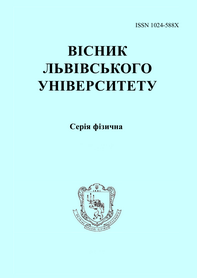DOI: https://doi.org/10.30970/vph.56.2019.103
Luminescent properties of microcrystals YVO4-Bi,Eu
T. Malyi, V. Tsiumra, A. Zhyshkovych, V. Vistovskyy, A. Vas'kiv, A. Voloshinovskii

| Visnyk of the Lviv University. Series Physics
56 (2019) ρ. 103-111
DOI: https://doi.org/10.30970/vph.56.2019.103 Luminescent properties of microcrystals YVO4-Bi,EuT. Malyi, V. Tsiumra, A. Zhyshkovych, V. Vistovskyy, A. Vas'kiv, A. Voloshinovskii |  |
YVO4:Bi,Eu microcrystals with different concentration of bismuth in the range 0.1-10 mol.\% and fixed europium concentration of 5 mol.\% were prepared by solid-state reaction. The obtained powders were characterized by X-ray diffraction and reveal single phase samples with tetragonal symmetry and I41/amd space group. The average grain size of samples was estimated as 5 {\mu}m by scanning electron microscopy measurements. Spectral luminescence parameters of Bi-doped YVO4:Eu microcrystals with different bismuth content (from 0.1 to 10 mol.\%) were studied. The luminescence spectra reveals broad emission band with maximum at 540 nm. The emission maximum slightly shifts to the higher wavelength region with increasing Bi3+ concentration in YVO4:Bi,Eu. This broad luminescence band corresponds to the emission of localized exciton near impurity Bi3+ ions \cite{c11}. The luminescence peaks in the range 580-720 nm correspond to the emission transitions from 5D0-state to slitted by spin-orbit interaction 7FJ–states (J = 1, 2, 3, 4) in Eu3+ ions. In the luminescence excitation spectra of Eu3+ ions (\lambdaem = 619 nm) the shift of absorption edge to the higher wavelength region within the increase of bismuth ions concentration is revealed. This shift is caused by the fact that the YVO4 lattice excitons are localized to Bi4+-V4+ type exciton in the vicinity of Bi3+ center \cite{c11}. This also indicates that there is an effective energy transfer from localized excitons to the luminescent centers of Eu3+. The modification of luminescence decay curves with the increase of bismuth ions concentration can be caused by the migration processes of excitation energy on Bi3+ ions in samples with Ρ \geqslant 2 mol.\%. YVO4:Bi,Eu have potential use for biological imaging as red luminescent marker.